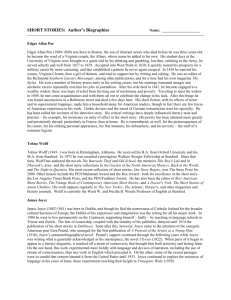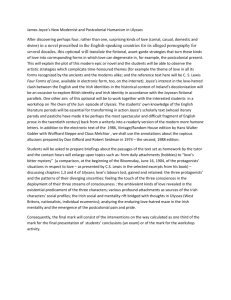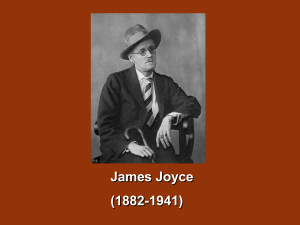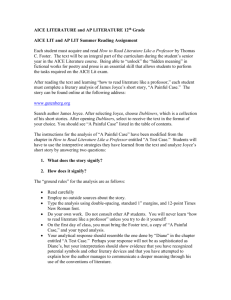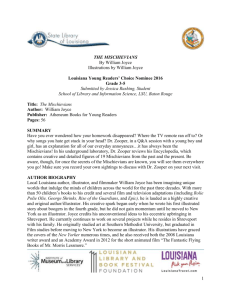Read the transcript of James Joyce here
advertisement
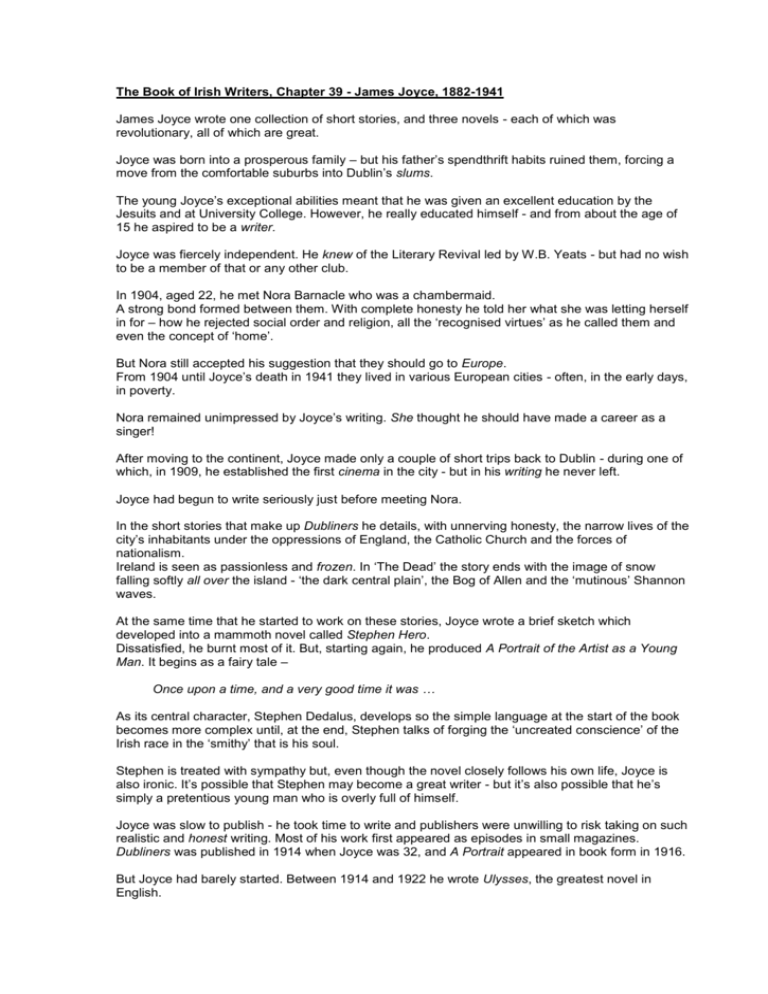
The Book of Irish Writers, Chapter 39 - James Joyce, 1882-1941 James Joyce wrote one collection of short stories, and three novels - each of which was revolutionary, all of which are great. Joyce was born into a prosperous family – but his father’s spendthrift habits ruined them, forcing a move from the comfortable suburbs into Dublin’s slums. The young Joyce’s exceptional abilities meant that he was given an excellent education by the Jesuits and at University College. However, he really educated himself - and from about the age of 15 he aspired to be a writer. Joyce was fiercely independent. He knew of the Literary Revival led by W.B. Yeats - but had no wish to be a member of that or any other club. In 1904, aged 22, he met Nora Barnacle who was a chambermaid. A strong bond formed between them. With complete honesty he told her what she was letting herself in for – how he rejected social order and religion, all the ‘recognised virtues’ as he called them and even the concept of ‘home’. But Nora still accepted his suggestion that they should go to Europe. From 1904 until Joyce’s death in 1941 they lived in various European cities - often, in the early days, in poverty. Nora remained unimpressed by Joyce’s writing. She thought he should have made a career as a singer! After moving to the continent, Joyce made only a couple of short trips back to Dublin - during one of which, in 1909, he established the first cinema in the city - but in his writing he never left. Joyce had begun to write seriously just before meeting Nora. In the short stories that make up Dubliners he details, with unnerving honesty, the narrow lives of the city’s inhabitants under the oppressions of England, the Catholic Church and the forces of nationalism. Ireland is seen as passionless and frozen. In ‘The Dead’ the story ends with the image of snow falling softly all over the island - ‘the dark central plain’, the Bog of Allen and the ‘mutinous’ Shannon waves. At the same time that he started to work on these stories, Joyce wrote a brief sketch which developed into a mammoth novel called Stephen Hero. Dissatisfied, he burnt most of it. But, starting again, he produced A Portrait of the Artist as a Young Man. It begins as a fairy tale – Once upon a time, and a very good time it was … As its central character, Stephen Dedalus, develops so the simple language at the start of the book becomes more complex until, at the end, Stephen talks of forging the ‘uncreated conscience’ of the Irish race in the ‘smithy’ that is his soul. Stephen is treated with sympathy but, even though the novel closely follows his own life, Joyce is also ironic. It’s possible that Stephen may become a great writer - but it’s also possible that he’s simply a pretentious young man who is overly full of himself. Joyce was slow to publish - he took time to write and publishers were unwilling to risk taking on such realistic and honest writing. Most of his work first appeared as episodes in small magazines. Dubliners was published in 1914 when Joyce was 32, and A Portrait appeared in book form in 1916. But Joyce had barely started. Between 1914 and 1922 he wrote Ulysses, the greatest novel in English. What’s important is Joyce’s use of language. During the nineteenth century, Irish had been displaced by English. For many this was a dispossession – but for Joyce, English was a gift which he could squander with the same extravagance that his father had squandered the family’s wealth. Joyce chose the Greek hero Ulysses as his model because he was a complete man - son, husband, father, lover – and he used cunning rather than what Joyce contemptuously called: … that immature brutality which is always so anxious to be mistaken for virility. Leopold Bloom, the central character of Ulysses, is an ‘unconquered hero’. Joyce uses the whole of western literary culture to describe one day in his life. This shows the richness and complexity of what is wrongly called ‘ordinary’ life. Having exhausted English, Joyce had to invent a new language for Finnegans Wake. His model was the wily Finn MacCumhaill, rather than the bloodthirsty Cuchulain - the hero of much of the writing in the Irish Literary Revival. Joyce drew again on a vast range of western culture and history as well as many Irish sources. He turns language into a form of music as a way of orchestrating human history. … reflecting from his own individual person ... the slow fires of consciousness ... perilous, potent, common to allflesh, human only, mortal. Where other writers looked to the past for epic heroes, Joyce was convinced that the present was the truly heroic age.

